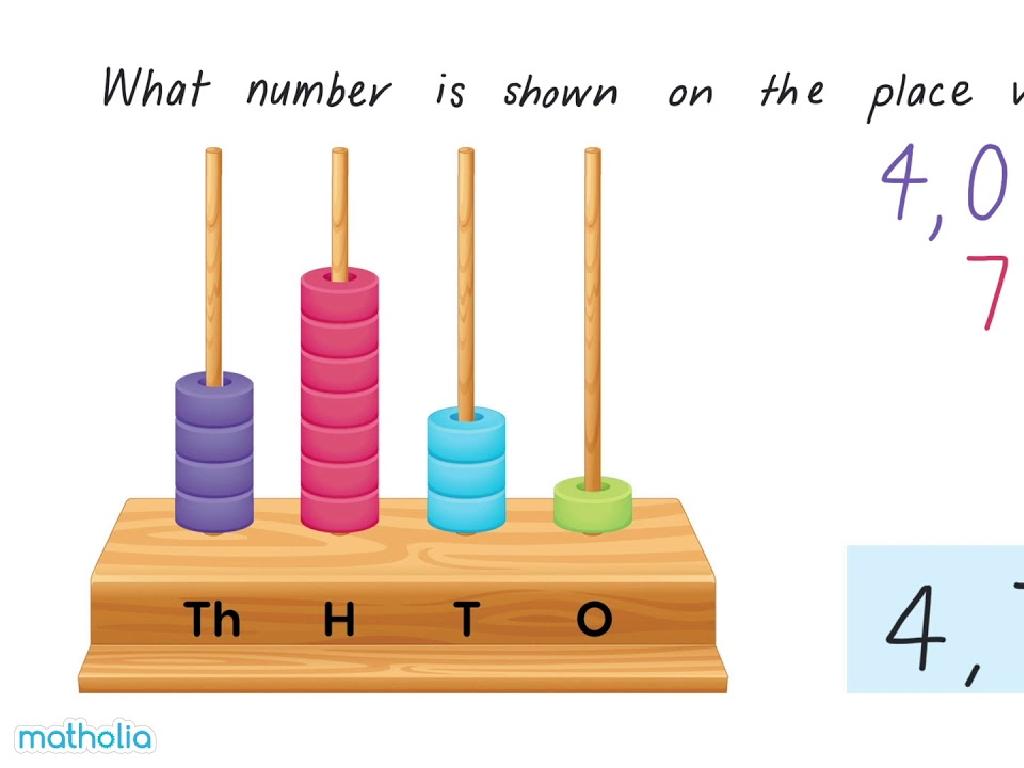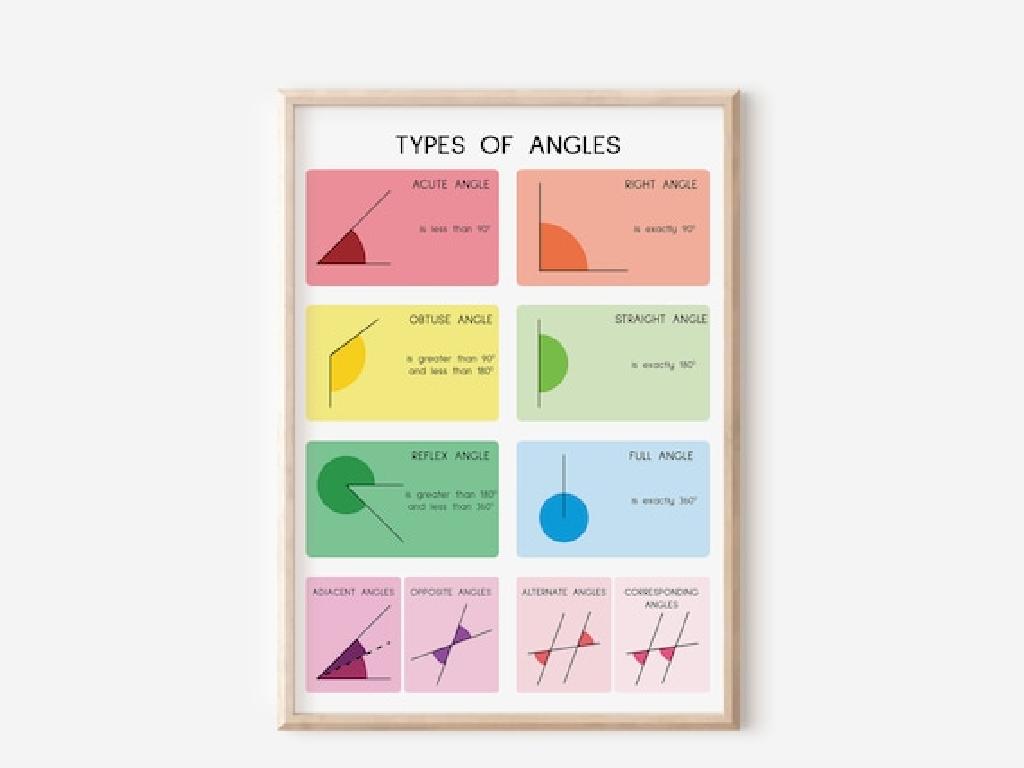Changes In Mean, Median, Mode, And Range
Subject: Math
Grade: Eighth grade
Topic: One-Variable Statistics
Please LOG IN to download the presentation. Access is available to registered users only.
View More Content
Exploring Measures of Central Tendency
– Statistics shape our understanding
– Statistics help us interpret data in various fields like weather forecasting, economics, and healthcare.
– Today’s focus: Mean, Median, Mode, Range
– Mean is the average, median is the middle value, mode is the most frequent, and range is the difference between the highest and lowest values.
– Importance of these measures
– They summarize large data sets to provide insight into patterns and trends.
– Real-world applications
– Examples include analyzing test scores, financial markets, or sports statistics.
|
This slide introduces the concept of one-variable statistics and its relevance in everyday life. Emphasize the role of statistics in making informed decisions and predictions. Explain each measure of central tendency: mean, median, mode, and range, and discuss why they are fundamental in summarizing and analyzing data. Provide examples to illustrate how these measures are used in real-world scenarios, such as calculating the average score on a test, determining the median income of a neighborhood, or finding the mode of a set of data points. Encourage students to think of additional examples where these measures could be applied.
Understanding Mean in Statistics
– Mean: The ‘average’ of numbers
– Mean reflects the central tendency of a data set.
– Calculate mean: Sum values / Number of values
– Add all numbers together, then divide by how many numbers there are.
– Example: Mean of 3, 5, 7, 9, 11
– (3+5+7+9+11) / 5 = 7. The mean is 7.
|
The mean, often referred to as the average, is a measure of central tendency that summarizes the data set with a single number. To calculate the mean, add all the values together and divide by the count of the numbers. For example, with the numbers 3, 5, 7, 9, and 11, the sum is 35. Since there are 5 numbers, divide 35 by 5 to get a mean of 7. This concept is fundamental in statistics and gives students a basic tool for data analysis. Encourage students to practice with different sets of numbers to become comfortable with the calculation process.
Understanding Median in Statistics
– Median: Middle value in ordered set
– Finding median in odd-numbered sets
– Arrange numbers and pick the middle one
– Finding median in even-numbered sets
– Average the two middle numbers
– Examples of calculating median
– Odd set: 3, 5, 7, 9, 11 (median is 7); Even set: 3, 4, 7, 8, 9, 12 (median is 7.5)
|
The median is a measure of central tendency that indicates the middle value of a dataset when ordered from least to greatest. For odd-numbered sets, the median is the middle number after arranging the data in order. For even-numbered sets, it is the average of the two middle numbers. Use the examples provided to illustrate the process: for the odd set (3, 5, 7, 9, 11), the median is 7, the middle value; for the even set (3, 4, 7, 8, 9, 12), the median is 7.5, the average of 7 and 8. Encourage students to practice with additional examples and to understand how the median can provide a different perspective on data compared to mean and mode.
Understanding Mode in Statistics
– Mode: Most frequent value
– The number that appears the most in a set of numbers.
– Multiple modes or none
– A dataset can have one mode, more than one (bimodal or multimodal), or no mode if all values are unique.
– Example: Mode of a dataset
– For the numbers 2, 4, 4, 4, 7, 8, 8, 9, the mode is 4 as it appears most frequently.
– Mode’s role in data analysis
|
The mode is a measure of central tendency that identifies the most common value in a dataset. When teaching mode, emphasize that a dataset may have one mode (unimodal), more than one mode (bimodal or multimodal), or no mode at all if all values are distinct. Use the example provided to show how to find the mode by counting the frequency of each number. The mode is particularly useful in understanding the distribution of categorical data. Encourage students to practice with different datasets to identify the mode and discuss scenarios where knowing the mode is beneficial in real-life data analysis.
Understanding Range in Statistics
– Definition of range
– Range is the spread between the lowest and highest values in a data set.
– Calculating range step-by-step
– Subtract the smallest value from the largest value in the data set.
– Example: Range calculation
– For the set 15, 22, 7, 34, 18, range is 34 (highest) – 7 (lowest) = 27.
– Significance of range in data
|
The range is a measure of how spread out the values in a data set are. To calculate the range, students should identify the highest and lowest numbers in the set and then subtract the lowest from the highest. In the example provided, the highest number is 34 and the lowest is 7, so the range is 27. This concept is important as it gives a quick sense of the variability in a data set. During the lesson, encourage students to practice with different data sets and understand how the range can change with the addition or removal of data points.
Impact on Mean, Median, Mode, and Range
– Effects of adding/removing numbers
– Adding a number can increase/decrease the mean, or leave it unchanged.
– Interactive example demonstrations
– Use class participation to alter a data set and observe changes.
– Significance of understanding changes
– Grasping these concepts aids in accurate data interpretation.
– Practical implications in statistics
– Helps in fields like economics, science, and even sports analytics.
|
This slide aims to explain how the mean, median, mode, and range are affected when numbers are added to or removed from a data set. Provide interactive examples where students can suggest numbers to add or remove and then calculate the new measures as a class. Emphasize the importance of understanding these concepts for accurate data analysis, which is a critical skill in various real-world applications. Discuss scenarios in different fields where these statistical tools are used, such as determining average incomes (economics), average temperatures (science), or sports performance statistics.
Real-Life Applications of Statistics
– Statistics in various fields
– Sports stats, economic trends, scientific research
– Decision making with mean, median, mode, range
– Analyzing central tendency helps in informed decisions
– Group discussion on statistics usage
– Share experiences where you’ve seen stats in action
– Understanding the impact of statistics
|
This slide aims to show students the practical applications of statistics in everyday life. Highlight how statistics are used in sports to track player performance, in economics to understand market trends, and in science to analyze data from experiments. Discuss how the measures of central tendency (mean, median, mode) and range are tools for making informed decisions. For the group discussion, encourage students to think about and discuss where they have encountered statistics, such as in the news, during sports games, or in their own experiences. This will help them connect classroom learning with the real world. The goal is to help students see the value of statistics in various aspects of life and how it influences decision-making processes.
Class Activity: Statistical Detectives
– Analyze a dataset in groups
– Find mean, median, mode, range
– Discuss changes to these measures
– How do additions or removals of data affect the results?
– Present findings to the class
|
This class activity is designed to engage students with practical application of statistical measures. Divide the class into small groups and provide each with a unique dataset. Their task is to calculate the mean, median, mode, and range of the data. Encourage them to consider how altering the dataset, such as adding or removing numbers, or introducing outliers, impacts these statistics. After the analysis, each group will present their findings, explaining the effects of data changes on the measures. Possible activities: 1) Adding a high outlier to see its effect on the mean. 2) Removing the highest or lowest number to observe changes in range. 3) Introducing a repeating number to create a mode. 4) Adjusting numbers to shift the median. This will help students understand the sensitivity of these measures to data changes.
Conclusion & Homework: Mastering Statistics
– Recap today’s statistics lesson
– Understand importance of statistical changes
– Homework: Analyze a dataset
– Find real-world data, could be sports scores or class test results
– Calculate mean, median, mode, range
– Use the formulas to compute each statistical measure
|
As we wrap up today’s lesson on one-variable statistics, it’s crucial for students to understand how mean, median, mode, and range can provide different perspectives on a dataset. For homework, students should find a dataset of interest, perhaps related to a hobby or area of interest, and calculate the mean, median, mode, and range. This will help solidify their understanding of how each measure is calculated and what it can tell us about the data. Encourage students to be prepared to discuss how each measure changes with the addition or removal of data points in our next class. Provide examples of datasets if needed and remind them of the formulas for each measure.






